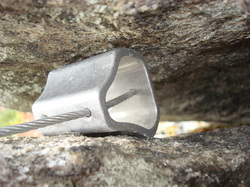Placing Protection
 A hex in a camming position placed in a horizontal crack
Placing traditional protection in the rock is perhaps the greatest barrier to trad climbing. First of all, trad gear is expensive. But even once you get it, you have to know how to use it. If you're lucky, you have a wonderful teacher that is patient and excited to show you the ropes. The perfect sensei, however, is hard to find for a lot of us. Diligent study and practice is necessary in order to eventually climb safely.
Before you begin reading this section on Traditional Protection, we strongly recommend reading our article on Basic Principles of Climbing Anchors. We've broken this section up into several sections: placing passive protection (i.e. no moving parts), placing active protection (things that "cam" in the rock), and using natural protection (like rocks, trees, chicken-heads, etc).To climb trad, you'll need to become proficient in all of these areas. |
At a Glance
Three types of trad protection:
|
Some Training Suggestions
- Practice making as many placements as you can standing on the ground. Place gear in your fireplace mantle, all around the base of your local crag, or the boulders in the park by your house. Get used to slotting the gear, finding good placements and selecting the correct piece for the crack in front of you. Have an experienced friend inspect your placements and correct your mistakes before you get on the sharp end. This will help develop your "trad eye." Soon you'll be walking around down town and notice great nut placements in the cracks on the sides of buildings.
- You can also practice leading a climb before actually leading it. This means you'll climb the route on top rope with one rope keeping you secure to the top rope anchor and another rope that you can faux-lead with. Find an easy one-pitch trad climb that can easily be top roped from above. Place gear along the route and attach your faux-lead rope to the placements as if you climb, but know that you are actually on top rope. Have an experienced friend second the climb and inspect your placements. Try to talk about every single one. Why did you place it there? Why in that orientation? What would have made it better? If you're feeling confident, you can lead the route. Alternative: If you have multiple people out at the crag with you, you can even have one person give you a lead belay and another person give you a very loose top rope belay. This will simulate a lead climb a bit more than simply having your faux-lead rope dangle to the ground. If you take a fall, it will somewhat simulate a leader fall, but the top rope will be right there to catch you.
- Climb easy routes to start off with. You may climb 5.12b on sport, but traditional climbs are a different beast. They require more stamina and more precision with gear placements. On your first few climbs you may have to cycle through 4 or 5 pieces before you find the one that fits the crack in front of you - making you nervous and pumped. Also, many of the sport routes out there seem to be graded a bit softer than the traditional routes. Bolted climbing is a relatively new phenomenon, so (as many an experienced climber will tell you), the grades tend to be a bit sand-bagged compared to the classic trad routes put up by those hard-core dudes back in the '60s.
